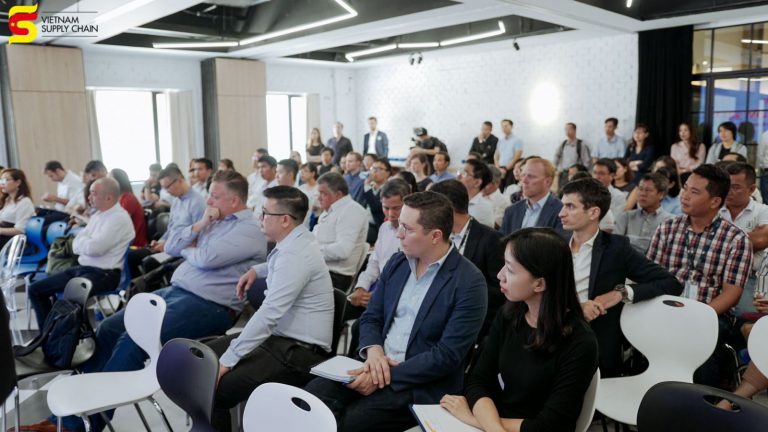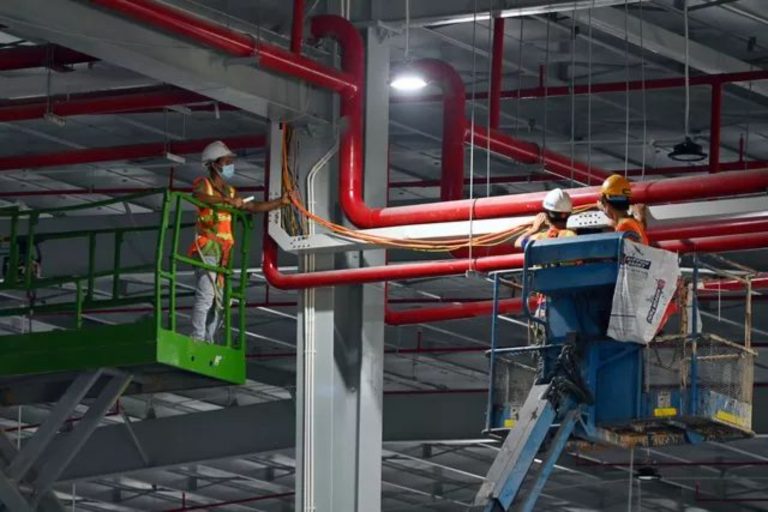DOWNLOAD FULL REPORT HERE
Ho Chi Minh City – May 2023
Over the last decade, Vietnam has emerged as one of the most sought-after manufacturing hubs across the region. The global geopolitical uncertainty has driven manufacturers to diversify their supply chain networks towards alternative hubs such as Vietnam.
In addition, Vietnam consumer spending is growing and is forecasted to continue to increase over the next few years, especially in terms of e-commerce. The e-commerce enjoys fast-paced annual growth of 25% during 2016 – 2021, and retail giants are also strengthening their foothold in Vietnam.
Given these, leasable areas are in high demand, while the potential supply-demand mismatch of warehousing space could be an issue. Limited industrial land bank, coupled with nationwide record low vacancy of 8% for land and 10% for warehouse, has amplified a structural shift towards multi-storey facilities.
In May 2023, CBRE released a special Joint Research Report with BW Industrial Development JSC. (BW) providing an overview of the Vietnam multi-storey warehouse and factory market, identifying potential opportunities and challenges, and assessing long-term trends that can help businesses adapt to production and supply network changes.
Development history: Multi-storey facilities have their roots in densely populated areas of Asia
A multi-storey warehouse or factory (hereafter called multi-storey facilities) consists of more than one floor, which supports a higher land utilization ratio and better operational efficiency. Floors above the ground floor are typically serviced by ramps, freight lifts, or conveyor systems, in which ramps allow trucks to access the different floors for loading and unloading cargo.
Multi-storey facilities have their roots in densely populated areas of Asia, in cities like Hong Kong, Singapore, Tokyo, Osaka or Shanghai, where demand is strong, but the land is constrained and expensive. It then appeared in Europe, the USA, and Australia due to its advantages.
Development history of multi-storey facilities in the world
 Source: CBRE Research, The Future is Multi-Storey, May 2023
Source: CBRE Research, The Future is Multi-Storey, May 2023
In Vietnam, the very first multi-storey factory was developed in Tan Thuan EPZ (HCMC) in 2015. More than 900,000 sqm from 15 facilities across the country have been launched since then. In the next three years, the market is expected to welcome an addition of 10 facilities, doubling the total leasable area.
Development history of multi-storey facilities in Vietnam
 Source: CBRE Research, The Future is Multi-Storey, May 2023
Source: CBRE Research, The Future is Multi-Storey, May 2023
Multi-storey developments are proving as good logistics platforms, with increased floor space efficiency, effective on-demand delivery and a focus on sustainability.
Due to the land scarcity challenges and rising occupier demand, land values continuously reach new heights. Location and accessibility become increasingly vital for industrial occupiers and their supply chain cost management. Given the fewer large leasable space near urban areas, multi-storey facilities with higher-density of land use is an optimal solution to tenants to better serve consumers’ growing demand for fast delivery.
E-commerce operation needs larger footprints not only for storing more merchandise but also for additional technology facilitating the picking, packing and reverse logistics. Following that, leasable areas have grown in size and multi-storey warehouses are the perfect options.
Consumer shipping expectations have been changing, in which fast delivery (perceived as same-day delivery) is key to winning over loyal customers. Given the limited industrial land close to consumer hubs (within 1 – 2-hour drive from the urban areas), multi-storey facilities mitigate supply chain issues by shortening delivery time and minimizing transportation costs (making up ~50% of the logistic spending).
Supported by modern construction, multi-storey factories can fully meet the demand from light and clean industries. Moreover, thanks to the provision of flexible leasable areas, multi-storey properties are well-suited for those in need of optimizing investment outlays, including small-to-medium-sized enterprises or new entrants with small-scale production at first.
Multi-storey warehouses can e¬fficiently use industrial land in urban areas and have a tremendous impact since they help significantly lower GHG emissions by reducing the distance between storage and customers. Fion Ng, Chief Operating Officer of BW Industrial Development, commented on this trend: “Reducing distance to customers by going multi-storey and making more efficient use of scarce land resources in urban areas goes a long way in helping to reduce environmental externalities as well. However, increasing density in an urban area also requires the support of other infrastructure such as road networks. Hence, choosing the right locations with easy highways access is critical.”
Why Multi-Storey? What’s causing the shift?
 Source: CBRE Research, The Future is Multi-Storey, May 2023
Source: CBRE Research, The Future is Multi-Storey, May 2023
Multi-storey warehouses/factories are on track to be rolled out faster in the next few years across Vietnam
Vietnam Multi-storey Facilities, Accumulated Supply

Source: CBRE Research, The Future is Multi-Storey, May 2023
As of Q4 2022, Vietnam had 513,957 sqm of leasing areas for multi-storey factories, with 70% in the Southern regions. Meanwhile, the total supply of multi-storey warehouses was 457,479 sqm NLA, with all the facilities in the Southern areas.
The expected supply to be added for the next five years is nearly 1,000,000 sqm NLA. Future projects mostly concentrate in provinces within one-hour of driving from two big cities, Hanoi and Ho Chi Minh City.
The vacancy of multi-storey properties across Vietnam currently stood at record lows, with an average rate of 20% for the North and 23% for the South in 2022. Given the massive warehousing demand fueled by e-commerce, coupled with the outstanding advantages of modern good-grade infrastructure in prime localities, multi-storey facilities earn a rental premium of 18 – 20% higher than single-storey ones. Some newly-operating projects since 2019 by well-known warehouse operators achieved high occupancy rate just after 1-2 years. Notably, Tan Dong Hiep B multi-storey warehouse in Di An (Binh Duong) by BW reached a good occupancy rate of 75% after only 6-month operation.
Regarding the tenant mix, multi-level factories are fit for light industries, with products mainly serving end-users rather than acting as intermediates for other sectors. Light industries are usually less capital-intensive and more consumer-oriented; hence, these tenant groups tend to locate their manufacturing base close to urban areas with a high concentration of customer base. In
Vietnam, food and beverage accounts for the majority of occupied space (20%), followed by plastic industry (19%), printing (18%) and electronics (13%).
For occupied space, the leasable area of 1,000 – 5,000 sqm is most favoured, substantially smaller than that recorded in single-storey ones with inquiries ranging from 5,000 – 10,000 sqm.
Due to its various advantages, switching from traditional industrial space to multi-storey ones is now on top of the list for both developers and occupiers. Building multi-level facilities with higher floor space utilization also helps to provide faster delivery with an effectively improved distribution network.
Commenting on the multi-storey facilities market trend in Vietnam, Ms Dung Duong, Executive Director, CBRE Vietnam, said: “In Vietnam, multi-storey establishments are not poised to overtake traditional ones anytime soon, but they are getting more common in urban areas. Cities and provinces like HCMC, Dong Nai, Binh Duong, Long An, Hai Duong and Bac Ninh are currently witnessing the most building activity of multi-storey warehouses/factories. As e-commerce continues to experience an unprecedented level of growth and fast delivery is vital in today’s world of business, we believe multi-storey facilities will have to be the future of the industrial market.”
END
© 2023, CBRE, Group Inc. CBRE Limited confirms that information contained herein, including projections, has been obtained from sources believed to be reliable. While we do not doubt their accuracy, we have not verified them and make no guarantee, warranty or representation about them. It is your responsibility to confirm independently their accuracy and completeness. This information is presented exclusively for use by CBRE clients and professionals and all rights to the material are reserved and cannot be reproduced without prior written permission of CBRE.
About BW Industrial Development JSC. (BW)
BW Industrial Development JSC (“BW”), established in May 2018, is a joint venture between Warburg Pincus – the leading global growth investor; ESR Cayman Limited – the largest APAC focused logistics real estate platform; and Becamex IDC, a pioneer developer of large-scale industrial townships in key markets across Vietnam. BW has focused on developing modern warehouses and light industrial to capture the outsized growth driven by the transformative shift of manufacturing bases to Vietnam, rising domestic consumption, and rapid growth of e-commerce.
Currently, BW is Vietnam’s largest and fastest-growing logistics and industrial for-rent platform, with over 8.15 million square meters of prime industrial land under control across more than 37 projects in 28 strategic economic locations throughout Vietnam. The developer currently has more than 2.94 million square meters GFA of completed or under construction properties.
About CBRE Group, Inc.
CBRE Group, Inc. (NYSE: CBRE), a Fortune 500 and S&P 500 company headquartered in Dallas, is the world’s largest commercial real estate services and investment firm (based on 2020 revenue). The company has more than 100,000 employees serving clients in more than 100 countries. CBRE serves a diverse range of clients with an integrated suite of services, including facilities, transaction and project management; property management; investment management; appraisal and valuation; property leasing; strategic consulting; property sales; mortgage services and development services. Please visit our website at www.cbre.com or www.cbrevietnam.com.
MEDIA CONTACTS
BW
Nhi Nguyen
Deputy Director – Communications
+84 906 242 239
nhi.nguyen@bwidjsc.com



